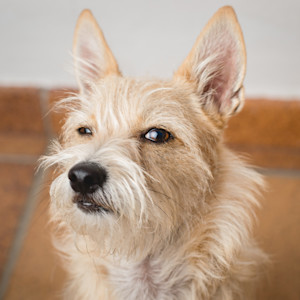Why Is My Dog’s Nose Turning Pink?
It’s cute, but checking that this isn’t a problem...
In This Article:
Why Do Dogs’ Noses Turn Pink? Common Reasons Why Dogs’ Noses Turn Pink When To See a Veterinarian For a Newly Pink Nose Are Some Dog Breeds More Likely to Have Pink Noses? How to Treat a Dog's Nose Color Changes Frequently Asked Questions
“My dog is acting fine, but I noticed that his nose looks a lot lighter than it used to. Is that normal?”
Vets get questions like this all the time. The truth is that dog noses can change color over time, and some breeds are more likely to show these changes. Although a dog’s nose can lighten or darken for benign reasons, there are some causes for color changes on a dog’s nose that indicate a problem.
Snap a pic of your pup’s teeth, and GREENIES™ will help you spot potential signs of oral health issues.
How much do you spend on your pet per year?
Why do dogs’ noses turn pink?
Dog noses come in a variety of colors, including black, liver (brown), blue (light to dark gray), or butterfly (also called parti — pink spots on one of the other colors). Pet parents may notice that their dog’s nose will change color subtly throughout the year, especially in dogs with liver-colored noses. This change can be due to alterations in the amount of sunlight exposure, skin conditions, trauma, or changes in the pigment-producing cells of the nose.
Common reasons why dogs’ noses turn pink
Snow nose
One of the most common and benign causes that a dog’s nose turns pink is snow nose. Also known as “winter nose,” this fading of the normal color of a dog’s nose usually happens in the fall and winter. Although the exact cause hasn’t been proven, it’s assumed that this color change is induced by decreased exposure to sunlight as the days shorten. It’s most commonly seen in dogs with liver-colored noses, though any nose type can be affected.
Dogs with snow nose may show a change in color over their entire nose or only in a stripe down the center and around the inside of the nostrils. No treatment is necessary for this condition, as the darker nose color usually returns when the skin of the nose produces more melanin in response to increased sunlight.
Lack of pigment
Some dogs, especially those with merle coats, are born with pink spots on their nose. Others can develop pigment loss over time due to vitiligo. Vitiligo is a cosmetic condition in which melanocytes (the cells that produce pigment in the skin) are destroyed in some areas. On the body, this results in white or light-colored patches of fur. On the nose, it appears as sharply defined pink spots that have a normal surface texture and no irritation.
Sun exposure
Too little sun can cause a dog’s nose color to fade, but too much sun can also result in pink spots. While the pigment on a dog’s nose helps protect the exposed skin from the sun, dogs with light-colored noses or those bathing in sunshine can get sunburned. Sunburns are most likely to develop along the edges where the nose meets haired skin. Just like in people, bad sunburns can cause enough damage to cause skin to die off and result in open wounds and pink areas.
Skin and health conditions
Unlike benign conditions like snow nose and vitiligo, numerous other conditions cause pink or red areas on the nose due to ulceration. Autoimmune diseases, localized infections, and skin cancer can all cause lesions on the nose.
Allergies
Many dogs have allergies to things like fleas, food, and the environment. While allergies alone do not generally cause the color of a dog’s nose to change, excessive facial rubbing or licking at the nose can result in raw areas. These pink abrasions will often be sore and may have a small amount of discharge when fresh.
Aging
As they age, some dogs may see a gradual decrease in the ability of the pigment-producing cells in the skin of their nose to produce melanin. A downtick in melanin production eventually results in a lightening of the color of the nose. This doesn’t happen to every dog, and the change may be so slow that you only notice when flipping through old pictures.
Drug side effects
Nose color changes aren’t usually caused by medications. There is a case report of a dog taking the anti-cancer drug toceranib (Palladia) developing multiple areas of depigmented skin, including on the nose. The color changes appeared about two weeks after starting the medication and resolved within weeks of stopping it.
When to see a veterinarian for a newly pink nose
Dog noses normally have a cobblestone appearance when looked at closely. This roughened texture is maintained in depigmented areas for benign conditions like snow nose and vitiligo. Any disruption of the nose’s normal texture could indicate a problem. Discharge, inflammation, bleeding, swelling, fissures, and open wounds are all reasons to get your dog’s nose checked out by your vet. To be safe it’s always best to inform your vet of any changes to your dog’s nose, even if they don’t seem bothered by them. Your vet may recommend an examination or just request some close-up pictures of the nose to make sure things look okay.
Are some dog breeds more likely to have pink noses?
Some breeds are predisposed to color changes on their noses. Snow nose seems to most frequently affect Siberian Huskies, Malamutes,Golden Retrievers, and Labrador Retrievers (especially chocolate Labs). But really, any yellow, brown, or tan dog with a liver-colored nose may experience some seasonal color change on their nose.
Vitiligo can be hereditary or develop spontaneously in dogs. Dachshunds, Doberman Pinschers, Rottweilers, Belgian Tervurens, and German Shepherds seem to be affected most commonly.
How to treat a dog’s nose color changes
The benign causes of color changes on a dog’s nose don’t need treatment. Some dogs may benefit from a dog-safe sunscreen on their nose to prevent sunburn if they’re going out in the sun for a long period. Excessive sun exposure to depigmented, unhaired skin can also increase the risk for squamous cell carcinoma, a type of skin cancer. Talk to your vet about strategies to prevent sunburn if your dog has pink areas on their nose.
Does tattooing pink areas help?
Some people have considered tattooing pink areas on a dog’s nose, either as a cosmetic or as a way to prevent sunburn. Tattooing dogs for cosmetic reasons is not acceptable in any situation. Tattooing does not prevent sun damage to skin in people or dogs since the ink sits beneath the outer layer of the skin, meaning that it is still exposed to the full extent of radiation from the sun.
Bottom line
Dogs’ noses change colors for many reasons, but the most common causes for pink areas on a dog’s nose are benign. While conditions like snow nose and vitiligo may alter your dog’s appearance, they don’t have negative health effects and dogs are generally unbothered by the change. They’re not spending much time focusing on how their nose looks, just what it can smell.
FAQs
Why do dog noses turn pink in the summer?
Seasonal lightening of a dog’s nose color usually occurs in the winter. A color change during the summer could indicate inflammation, irritation, or infection.
What should you do to prevent snow nose?
Because snow nose is a normal seasonal variation in some dogs’ nose color, it’s not necessary to try to prevent it from happening.
What is snow nose?
Snow nose is a natural lightening of the color of a dog’s nose, likely due to decreased sun exposure during the winter.
Will a dog’s nose turn black again?
Most dogs with snow nose recover their darker nose color as days lengthen. Pink areas on the nose due to vitiligo will not regain pigmentation with time.
Do metal bowls turn dogs’ noses pink?
Metal bowls should not turn a dog’s nose pink unless the dog is rubbing their nose excessively in the bowl or allergic to a component of the bowl.
Why do Golden Retrievers’ noses go from black to pink?
Golden Retrievers are one of the breeds predisposed to snow nose, so they may have seasonal changes to the color of their nose.
References
Alhaidari et al. “Melanocytogenesis and melanogenesis: genetic regulation and comparative clinical diseases.” Veterinary Dermatology vol. 10,1 (1999): 3-16. doi:10.1046/j.1365-3164.1999.00132.x
Burton, Greg and David Robson. "Diseases of the Canine Nasal Planum." Proceedings of the Australian Veterinary Association, 2008.
Beale, Karin M. “Differential diagnosis of nasal dermatitis in dogs.” Proceedings of the Western Veterinary Conference: Las Vegas, NV, 2002.
Cavalcanti, Jacqueline V J et al. “Skin depigmentation associated with toceranib phosphate in a dog.” Veterinary Dermatology vol. 28,4 (2017): 400-e95. doi:10.1111/vde.12422
Chan, Tim, and Andrea T H Lam. “Nasal planum diseases in dogs.” The Canadian Veterinary Journal vol. 65,5 (2024): 514-519.











